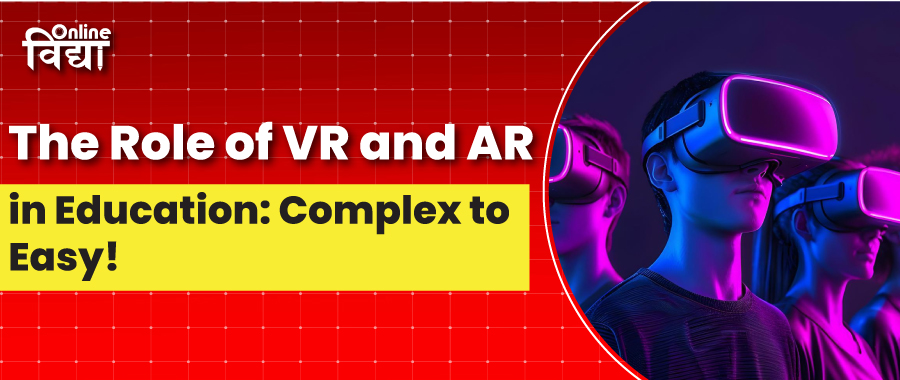Specializations
Courses Available
Courses

The Role of VR and AR in Education: Complex to Easy!
The Role of VR and AR in Education: Complex to Easy!,May 15, 2025
Online BA
May 15, 2025
1108 Views
- Share:
Technologies such as 3D, augmented reality, and virtual reality (VR) are now applicable to any discipline involving educational procedures. In the natural sciences, social sciences, and humanities, these technologies have helped students across the globe to comprehend complex issues, use their knowledge to solve problems, and communicate with people from diverse cultural backgrounds.
Transform Learning with AI and Immersive Reality
- Artificial intelligence and virtual reality will transform education into being effective, inclusive, and exciting.
- In addition to AI tracking progress, personalizing study pathways, and adjusting content on the fly, immersive environments let students investigate difficult concepts for themselves.
Virtual reality: what is it?
Virtual reality is a computer simulation that alters the way humans experience the real world. In a literal sense, virtual reality is a world with realistic objects and fake landscapes. Using some technical devices, such as glasses or helmets, one may view alternative worlds from his own and feel them as real.
Virtual reality (VR) has been employed in education to enable students of various cultural backgrounds to bond and grasp complex topics since it creates extremely real-feeling parallel universes. Cultural diversity, respect, and tolerance of differences can be learned through virtual reality.
Teachers' Use of Virtual Reality in Education
Teachers' jobs and the education industry are being transformed by virtual reality. Teachers used pedagogies and little technology in physical classrooms before the COVID-19 pandemic. Nowadays, as the transition to virtual learning environments continues to become more apparent, educators desire to focus on making knowledge more accessible to students using technology.
Virtual reality (VR) strengths in educational applications
Since it has made class learning process better, augmented reality has positively contributed to education. For instance, since AR allows one to describe basic procedures such as diameters, area, and circumference, it has drawn particular focus in the area of teaching geometry. Virtual reality provides spaces for experiences on a scale that leads to hands-on learning. They can employ virtual reality (VR) to visualize complicated topics instead of books if they feel it's necessary.
What do you understand by AR (Augmented Reality)?
AR is a widespread technology set for users to access essential facets of their environment, using mobile devices such as tablets and smartphones to seize information from the environment, and augmenting reality with different types of overlaying graphics, sounds, images, and video anywhere within a defined space. AR may include the camera, sensors, computation, projection, and reflection as needed to realize this.
In augmented reality, sensors and cameras recognize an image and determine the distance between two objects. Users thus develop a perception of the reality they perceive. Consequently, AR blends virtual elements that enrich the user's experience of reality with their view.
What is the use of AR?
By integrating students into the presentation, speakers can employ augmented reality (AR) to engage with the audience and transmit messages. In a lesson, for example, educators can assist students in comprehending specific concepts or images. AR may be an integral element in research and development projects for companies and universities.
Since it has facilitated the enhancement of classroom learning activities, augmented reality has positively impacted education.
AR's benefits in education
Since AR brings creativity and innovation into pedagogical processes, it has exclusive advantages for education and classrooms. AR can potentially substitute outmoded methods of education with more innovative pedagogies.
For example, augmented reality devices can be utilized alongside lessons to enhance the understanding of students of a specific subject.
When applied to the classroom setting, children acquire knowledge more proficiently and become more engaged. Augmented reality (AR) can trim instructional costs while helping instructors teach various courses in innovative and creative methods if utilized appropriately.
Last Few Words
Learning methods and traditional pedagogical practices have been entirely revolutionized by VR and AR technologies. In contemporary times, the transition from face-to-face teaching centered on printed books to more participatory pedagogic methods involving large amounts of information and complex issues has been bolstered by contemporary technologies.
Commitment from students to their knowledge creation processes is bolstered by such technologically facilitated methods, and they also enable them to learn challenging ideas from the humanities, social sciences, and natural sciences quickly.
Because these technologies facilitate the student to engage with individuals of diverse cultures, they have even proved useful for the creation of inclusive and diverse learning environments.
The incorporation of virtual and augmented reality technology into educational curricula and, by extension, collaboration between learning institutions and the business community in teaching activities must be enhanced.
FAQs
Why do educators consider VR?
VR technology used to infuse and transform the education process is called VR education. This technology puts students inside simulated environments with realistic incidents and allows them to interact with virtual people and objects.
What role does AR play in education?
AR engages students throughout the course by leveraging gamified and interactive learning. Learning becomes easy and enjoyable as a result. Virtual worlds and other immersion tactics enable students to dig deeper into the course material. Lessons feel more engaging, relevant, and real as a result.
What are AR and VR's potential uses?
VR and AR design have many different applications. Virtual reality allows architects to create detailed, interactive models of spaces and buildings so clients can visit and inspect them before they are built.

Meet Our Counselling Experts
Get 100% Free Career Counseling




PlacementPartners










Schedule Your 30 min Couselling Session With Today!!
Select a Date of your choice :
You Have Selected Slot on .

